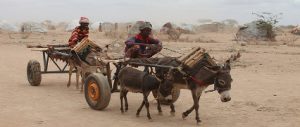How agricultural land is owned, what is grown on it, and by whom, will probably determine much of the next century’s politics, profits and, possibly, revolutions.
Western investors tend to see land and commodity assets as a more secure alternative to the volatile stock and bond markets, and an opportunity to tap into lucrative biofuel and forestry markets. But for countries like Saudi Arabia, India and China, where water scarcity compromises food production, the acquisition of farmland to grow and import food has come to be seen as a matter of national security.
Both of these trends are resulting in large-scale acquisitions of land in regions where the soil is still fertile and water still available. In sub-Saharan Africa alone, in just 10 years, over 100 million hectares have been leased to investors for agricultural development by host governments often accused of ignoring the interests of communities living on the land. In places like Sudan, Mozambique, and Ethiopia, land deals are raising widespread concerns over forced evictions and social vulnerability.
Significantly, managing soil erosion, ensuring human security and keeping within ecological limits, especially regarding water, are risks to the long-term value of the land, the portfolios of investors and the economic competitiveness of host countries. As global agribusinesses face growing social and environmental pressures, investors seeking to manage the resulting risks will require an innovative approach to risk management: including ecological limits and human security in the agricultural equation.
Large-scale farming still operates in the bygone world of the Green Revolution, relying on the heavy use of chemicals and intensive, mono-crop cultivation as a means to boost agricultural output. Instead, what might a transition to a Green Economy model look like?
Just as large carmakers have turned to electric cars, large agribusiness firms may have to consider turning to organic farming to ensure the long-term value and resilience of the soil. Just as new business models benefit from thinking in terms of distributed networks, such as car-sharing schemes in large cities, so too agricultural models can better integrate networks of smallholder farmers into a radical rethink of their business models, to build the social resilience that is needed to cope with a growing population. Incentives for pursuing these innovations are more likely to arise from fully understanding the risk challenges involved in the current model than from appeals to global sustainability.
For example, investors are beginning to understand the extent to which soil erosion challenges the long-term productivity of agricultural investments. For investor Jeremy Grantham, the co-founder of GMO, an investment fund with US$93 billion in assets under management, soil erosion figures among the main concerns on commodities investments. “In Australia,” he writes in a quarterly analysis, “where records go back into the nineteenth century, it is also clear that more than 70% of arable land has been degraded to some considerable degree. For the planet as a whole, soil losses are certainly higher than replacement, and for some areas, notably in Africa, they are disastrously higher.”
In the United States, to cite another example, an exponential growth in pests that have effectively adapted to pesticides, including herbicides like glyphosate, is leaving US farmers either unable to shoulder the costs of additional chemicals or having to experiment with untested chemical cocktails that are likely to increase the toxicity of water supplies and the soil. Investment analysts have signalled that the growing resistance of pests to chemical pesticides is a cause for concern for investors in agrochemical companies.
Ecological limits are forcing farmers to acknowledge the importance that a healthy environment has on long-term agricultural productivity. After 30 years of scientific research – the longest-running scientific comparison between organic and conventional agriculture – the Rodale Institute, in the United States, found that organic farming, although providing lower yields in the first years, in the long term outperforms conventional chemical farming in terms of crop yields, sustainability and profit.
Part of this paradigm shift means viewing the fertility of the soil and the diversity of supporting ecosystems as “natural assets” that must be taken into account in the agricultural economic equation. In sub-Saharan Africa, where farmers are either too poor to afford chemical options or the distribution models are not sufficiently developed, natural ways of fixing nitrogen into the soil are driving agricultural innovation which can offer considerable insight to more developed nations.
One example is “fertiliser tree systems”: by planting certain types of nitrogen-fixing trees alongside crops, farmers have managed to boost crop fertility, while increasing the biological diversity needed to face climate changes, such as more frequent droughts. In making the transition from Green Revolution to Green Economy, investors in farmland and agribusiness must start to think seriously about investing in resilience.
Given the typically low levels of government accountability in sub-Saharan Africa, land investments, even if entered into by well-meaning investors, can have dire consequences for local communities. The unintended risks to human security may be significant, whether because these communities are forcibly evicted from the public lands they have cultivated, often without formal rights, for generations, or because new irrigation schemes jeopardise water availability for small-scale subsistence farming.
The growing social instability and vulnerability created by this booming industry is growing in visibility. Media spotlights on particular projects, for example a biofuel development in Tanzania, have raised alarm – and show just how material these reputational and political risks are for investors and companies.
Taking human security into account can be a good strategy for farmland investments, even if it means going beyond the investor’s legal responsibility, especially where governments cannot be relied upon to play their part. Ethiopia, for example, reportedly offered to lease three million hectares to foreign investors for agricultural production at a time when 2.8 million Ethiopians are suffering from hunger. While such investment deals may boost food or commodity exports, human security concerns – and the likely growth of land-related conflicts – should find their way to the top of the business and investment agenda.
A proactive approach is needed to ensure the transparency of investment deals and bridge the gap between formal and informal land rights held by communities. History shows that, as with other areas where governments have been slow or sloppy to respond – see, for example, Apple’s recent standoff over the environmental footprint of its supply chain in China – the private sector will be held to account. This approach should include ways of involving and benefiting local communities, not only through their informed and prior consent to these deals, but also with options that build their capacity and livelihood to participate in development.
The situation in Mali, in west Africa, illustrates the challenges that lie ahead. A recent study aggregated all the new land deals entered into by the government of Mali and found that, if they are all fully developed, it is likely that there won’t be enough water in the Niger River to irrigate them. The availability of water and water rights that come with land rights will be the main point of contention.
Two large investments there are said to require more than half of the critical reserve of water for the dry season, and have exclusivity of water service in emergency drought situations. Some of the new contracts take water rights for granted. A large irrigation canal is being built to cater for the needs of industrial-scale agriculture by Libyan investors; it is said to affect the water supply for more than 90,000 hectares of land used by small-holder farms for subsistence, as well as cutting routes of passage for livestock.
Climate change and recurrent droughts, which are difficult to predict, are likely to aggravate the situation. Land contracts that give preferential access to water resources, or fail to consider water rights, should be a point of concern for investors – as should the overall institutional capacity of government agencies to manage the water availability of a region.
Ecological limits also create unintended consequences. For example, since 2004, Saudi Arabia has leased more than 376,000 hectares from the Sudanese government to grow rice, a water-intensive crop. Weak water regulation has forced the Sudanese government to halt its wheat production because of water scarcity, which in turn has reduced grain supplies and increased its price on the local market.
Therefore, a fundamental shift must take place in how investors and governments consider the long-term value of the land. Everyone’s interests are undermined by surpassing ecological limits, allowing soil erosion and disregarding human rights when it comes to land issues.
Progress depends on host governments being more accountable and transparent in managing land issues. This is easier said than done, so it can’t just be left to governments to figure out. A forthcoming report by the Earth Security Initiative, The Land Security Agenda, identifies a series of proposals for investors, NGOs and other stakeholders to collaborate on bringing these issues into the day-to-day decision-making of governments and financial markets.
Pressure from civil society for greater transparency is increasing. A research partnership led by the International Land Coalition aims to create the world’s largest database on large-scale land investments. Initial steps are also being taken through the Principles for Responsible Investment’s (PRI) Farmland Working Group, where six pension funds are pooling their combined US$1.3 trillion (8.2 trillion yuan) in assets to explore how to drive more responsible investments. Considerable opportunities exist for cooperation among these stakeholders; precisely how investors implement transparency is still undecided.
Obtaining the “prior and informed consent” from local communities for large-scale investments is becoming a central demand from civil society. Framing this in terms of compliance is important, but more important from a business perspective will be to create more inclusive value chains that offer local communities participation in development. Cooperatives can help aggregate and coordinate supply. Where technical assistance is needed to help these communities up their game, development agencies are likely to step in to better direct the investments that agencies are already doing in this area.
With global financial markets in turmoil, investors regard land assets as a safe bet. This may not necessarily be the case. But incorporating soil resilience, human security and ecological limits into the equation is essential to fully understand what lies ahead, and managing these risks offers an extraordinary opportunity to move the sustainability agenda forward. Everyone has a stake in trying to make the land agenda work in the long-term.
Alejandro Litovsky is founder and director of the Earth Security Initiative.
Homepage image by CGIAR Climate



